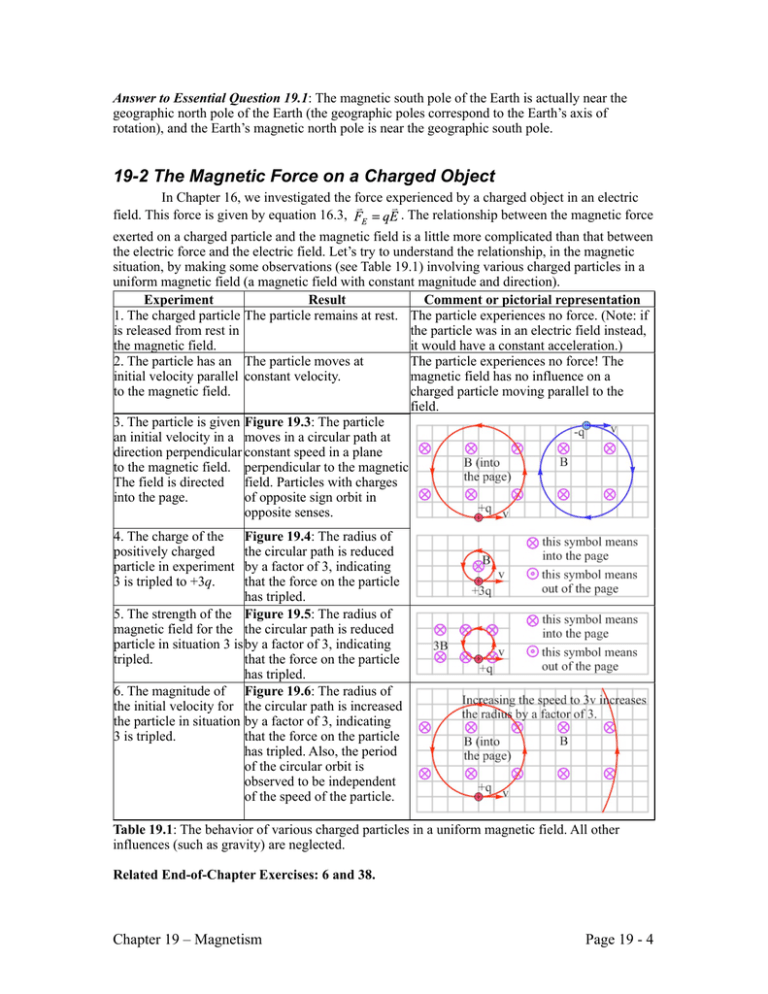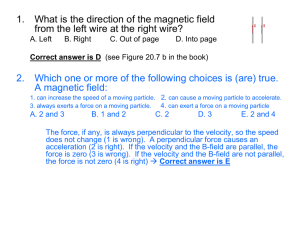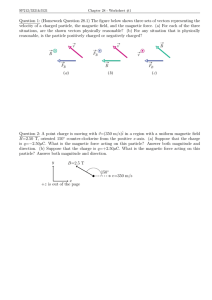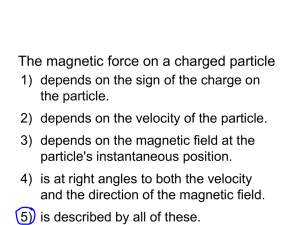19-2 The Magnetic Force on a Charged Object
advertisement

Answer to Essential Question 19.1: The magnetic south pole of the Earth is actually near the geographic north pole of the Earth (the geographic poles correspond to the Earth’s axis of rotation), and the Earth’s magnetic north pole is near the geographic south pole. 19-2 The Magnetic Force on a Charged Object In Chapter 16, we investigated the force experienced by a charged object in an electric field. This force is given by equation 16.3, . The relationship between the magnetic force exerted on a charged particle and the magnetic field is a little more complicated than that between the electric force and the electric field. Let’s try to understand the relationship, in the magnetic situation, by making some observations (see Table 19.1) involving various charged particles in a uniform magnetic field (a magnetic field with constant magnitude and direction). Experiment Result Comment or pictorial representation 1. The charged particle The particle remains at rest. The particle experiences no force. (Note: if is released from rest in the particle was in an electric field instead, the magnetic field. it would have a constant acceleration.) 2. The particle has an The particle moves at The particle experiences no force! The initial velocity parallel constant velocity. magnetic field has no influence on a to the magnetic field. charged particle moving parallel to the field. 3. The particle is given Figure 19.3: The particle an initial velocity in a moves in a circular path at direction perpendicular constant speed in a plane to the magnetic field. perpendicular to the magnetic The field is directed field. Particles with charges into the page. of opposite sign orbit in opposite senses. 4. The charge of the positively charged particle in experiment 3 is tripled to +3q. Figure 19.4: The radius of the circular path is reduced by a factor of 3, indicating that the force on the particle has tripled. 5. The strength of the Figure 19.5: The radius of magnetic field for the the circular path is reduced particle in situation 3 is by a factor of 3, indicating tripled. that the force on the particle has tripled. 6. The magnitude of Figure 19.6: The radius of the initial velocity for the circular path is increased the particle in situation by a factor of 3, indicating 3 is tripled. that the force on the particle has tripled. Also, the period of the circular orbit is observed to be independent of the speed of the particle. Table 19.1: The behavior of various charged particles in a uniform magnetic field. All other influences (such as gravity) are neglected. Related End-of-Chapter Exercises: 6 and 38. Chapter 19 – Magnetism Page 19 - 4 For experiments 3 – 6 in Table 19.1, the particles experience uniform circular motion, so we can apply the analysis methods we used in Chapter 5. The net force on the particle, which is directed toward the center of the circle, comes from the magnetic field. Thus, the magnitude of the magnetic force on a particle of mass m and speed v is: . Solving for the radius, r: . (Equation 19.1) In experiments 4 and 5, the mass and speed of the particle are constant. Thus, any change in radius comes from a change in the force. In Experiment 4, tripling the charge decreases the radius by a factor of 3, so the magnetic force must increase by a factor of 3. Thus, we conclude that the magnetic force is proportional to the charge. Analyzing experiment 5 in the same way, we conclude that the magnetic force is proportional to the magnitude of the magnetic field. The results of experiment 6 are interesting. Based on Equation 19.1, we might expect that tripling the speed would lead to an increase in radius by a factor of 9. Because we observe that the radius increases by a factor of 3, we conclude that there must be a factor of v hidden in . In other words, the magnetic force on a charged particle is proportional to the speed of the particle. Let’s write a compact equation for the force exerted by a magnetic field on a charged particle. , where (Eq. 19.2: The magnitude of the magnetic force on a charge q) is the angle between the velocity, the force is perpendicular to the plane defined by , and the magnetic field, and . The direction of , and given by the right-hand rule. The right-hand rule for determining the direction of the magnetic force on a moving charge First, make sure you use your right hand! Also, refer to Figure 19.7. • Point the fingers on your right hand in the direction of the charge’s velocity. • While keeping your fingers aligned with the velocity, rotate your hand so that, when you curl your fingers, you can curl them into the direction of the magnetic field. • Hold out your thumb so it is perpendicular to your fingers. Your thumb points in the direction of the force experienced by a positively charged particle. • If the particle has a negative charge, your right hand lies to you. Just reverse the direction of the force. The magnetic force on a negatively charged particle is opposite in direction to that of a positively charged particle if the particles are traveling in the same direction. Figure 19.7: To find the magnetic force on a charged particle moving in a magnetic field, point the fingers on your right hand in the direction of the velocity, as in the photo on the left. Orient your hand so you can curl your fingers into the magnetic field, as in the photo on the right. Keep your thumb perpendicular to your fingers, and your thumb points in the direction of the force experienced by a positive charge (out of the page, in this case). A negative charge experiences a force in the opposite direction. Photo courtesy of A. Duffy. Essential Question 19.2: A charge with an initial velocity directed parallel to a magnetic field experiences no magnetic force, and travels in a straight line. If the initial velocity is perpendicular to the field, the particle travels in a circle. Predict the shape of the path followed by a charge with a velocity component parallel to the field, and a velocity component perpendicular to the field. Chapter 19 – Magnetism Page 19 - 5



